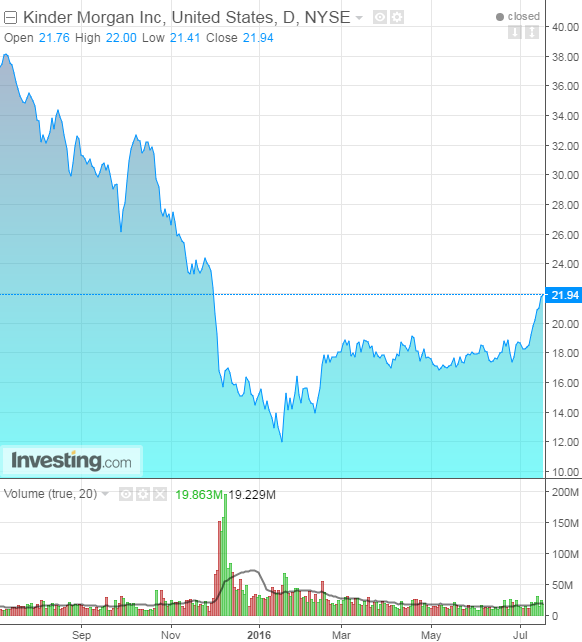by Clement Thibault
Energy infrastructure giant Kinder Morgan Inc (NYSE:KMI) reports on Wednesday, July 20, after the close.

1. Revenue and Earnings forecast
Kinder Morgan's forecast for Q2 2016 is $0.15 EPS on $3.51B expected. Meeting analyst expectations would mean Kinder Morgan has managed to regain the sort of EPS numbers it reported during Q2 last year, after its disappointing marginal results at the end of 2015, when the company reported EPS of $0.08 and -$0.33 for Q3 and Q4, respectively.
2. Crushing Debt
The biggest threat Kinder Morgan currently faces is, without doubt, the massive amount of debt is has taken on. While debt isn't usually a major issue when it contributes to growth, it becomes more difficult to deal with when corporate strategy doesn't go according to plan. For energy companies, the plunge in oil and gas prices to historically low levels was surely not what anyone expected.
According to its Q1 release, Kinder Morgan had over $43B of outstanding debt, down just 3% from Q1 2015, when its liability was $45B. Kinder Morgan's EBITDA of $4.5B TTM means that the company is highly leveraged. Its Debt-to-EBIDTA ratio of 9.5 is a huge red flag. In comparison, one of Kinder's main competitors, Enterprise Products Partners LP (NYSE:EPD), which is 25% larger than KMI based on market cap, has approximately half the debt, and a Debt-to-EBIDTA ratio of 6.4. That's still high, but EPD's numbers underscore just how perilous the financial situation is for KMI.
3. Positive Steps To Reduce Its Debt
Fortunately, it appears that Kinder Morgan is finally keen on solving its debt problem, and has taken several positive steps over the past quarter. Less than two weeks ago, on July 10, the company announced a $4.15B deal with Southern Company (NYSE:SO), regarding Kinder's Southern Natural Gas pipeline, a 7,600 system which connects 4 supply basins in the US south with markets in Louisiana, Alabama, Florida, Georgia, South Carolina and Tenessee.
According to the terms of the deal, Southern will pay $1.47B in cash and assume $2.68B in debt for a 50% stake in the pipeline. In addition, Southern will participate in 50% of future capital expenditure costs.
On top of this deal, Kinder sold a 50% stake in its Ohio-based Utopia pipeline to the Riverstone Investment Group for a 50% reimbursement of previous capex costs as well as half of the pipeline's funding costs going forward. The total project cost is estimated to be $500M. Additionally, 50% of yet another pipeline, Parkway, has been sold to refining company Valero Energy (NYSE:VLO), for an undisclosed sum of cash.
These three deals, as well as the fact that KMI canceled the planned construction of several other pipelines, prove that the company is appropriately focusing on its massive debt load, and actively trying to unload it from its balance sheet. That's always a good sign from an investor perspective, signaling that the company is making moves to secure its future.
4. Whither KMI's dividend?
Kinder Morgan was once an attractive dividend payer. When oil prices plummeted, Kinder's shares fell in conjunction, raising its dividend yield to a rich 7-8%.
Unfortunately, the plunge also hurt KMI's profitability, and Kinder could no longer pay as big a dividend. On October 21, 2015, the company began scaling back promises for 2016 dividends, eventually slashing the payout by 75% this past December.
The uncertainty surrounding its dividend, and the eventual cut, caused the stock to fall by 50%—from $31 in October to $15 on December 8th, the day the cut was announced. The company is still trying to recover.
Nevertheless, to its credit, KMI has continued to pay some dividend, currently $0.125 quarterly. It's a smart gesture aimed at current and future investors, showing that Kinder Morgan is still committed to shareholders. And this quarter is especially important because of Kinder's payout ratio.
Because the company hands out a quarterly dividend, it must make a higher EPS number to show that the dividend is sustainable. Last quarter's EPS was $0.12, pushing the payout ratio above 100%. While a quarter or two above 100% isn't always catastrophic, for a highly-leveraged company that has already hurt shareholder confidence with a dividend cut, it is critical to be able to report an EPS numbers above the dividend threshold.
Conclusion
We believe investors should take a wait-and-see approach. Kinder Morgan management is taking favorable steps to try and secure the future of the company, but they did surprise shareholders with the harshness of the dividend cut in December.
Like the entire energy sector overall, Kinder Morgan's situation is also dependent on the price of oil price, which for now has stabilized around $45. The company is headed in the right direction, but these are early stages. The risk/reward proposition for Kinder Morgan will be more positive once the company re-establishes EPS growth.
